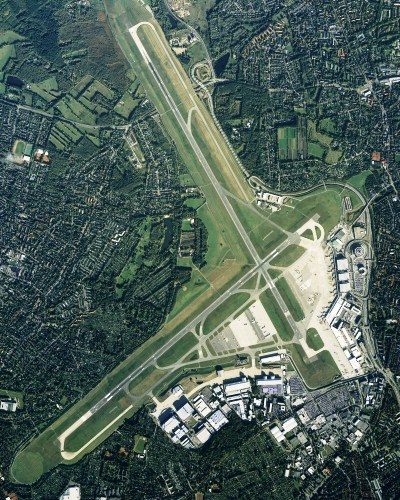On January 10, 2011 Hamburg Airport celebrated its 100th birthday, making it one of the world’s oldest commercial airports and the oldest facility in Germany. The fact that the airport is still at its original location makes this anniversary even more special. On a site where 100 years ago, an airship hangar once stood and sheep used to graze, there is now a flourishing international airport that handles more than 35,000 passengers per day through its two terminal buildings. While most airports built in the early 20th Century were located within city boundaries, Hamburg Airport was built on the outskirts of the city, showing amazing foresight and enabling it to develop into Northern Germany’s largest international airport, a major employer and an economic driving force in a region that is ranked the third largest aviation powerhouse thanks also to the activities of Airbus and Lufthansa Technik.
|
TRAFFIC STATISTICS: HAMBURG AIRPORT |
|||||||||||
|
YEAR |
2000 |
2001 |
2002 |
2003 |
2004 |
2005 |
2006 |
2007 |
2008 |
2009 |
2010 |
|
PASSENGERS (millions) |
9.9 |
9.5 |
8.9 |
9.5 |
10.0 |
10.7 |
12.0 |
12.8 |
12.8 |
12.2 |
13.0 |
Hamburg Airport’s growth has been amazing, increasing from 9.9 million passengers in 2000 to 13.0 million in 2010; a 31.3 per cent growth during a period that many other major airports across Europe suffered from the challenging global economic climate. This development has been directly linked to a proactive network development strategy that has seen five new airlines confirm new services in the past 12 months, six new routes being started by existing carriers and increased frequencies on flights to some key destinations. The most notable of the new arrivals has been China Eastern Airlines which inaugurated a twice weekly connection to Shanghai Pu Dong on August 30, the airport’s only current direct link to Asia. Earlier in the year Spanair had introduced a three times weekly link to Barcelona and Icelandair a twice weekly flight to Keflavik, while RAK Airways will add a weekly service to Ras Al Khaimiah on October 1 and Viking Hellas Airlines will introduce a fortnightly link to Athens, with onward connections to Iraq from October 29.
The most notable of the new arrivals has been China Eastern Airlines which inaugurated a twice weekly connection to Shanghai Pu Dong on August 30, the airport’s only current direct link to Asia. Earlier in the year Spanair had introduced a three times weekly link to Barcelona and Icelandair a twice weekly flight to Keflavik, while RAK Airways will add a weekly service to Ras Al Khaimiah on October 1 and Viking Hellas Airlines will introduce a fortnightly link to Athens, with onward connections to Iraq from October 29.
Existing airlines have also expanded their offerings from Hamburg, including easyJet adding a six times weekly link to Manchester in November 2010, Croatia Airlines a twice weekly link to Split in April and airberlin a twice weekly flight to Keflavik in June. TUIfly has also announced the launch of a weekly flight to Boa Vista and Sal in Cape Verde from November 1 and Condor Airlines a new twice weekly link to Klagenfurt in December. There have also been frequency increases…Emirates Airline added a second daily flight to Dubai on September 1 and Turkish Airlines (THY) a third daily rotation to Istanbul in April. British Airways (BA) has also confirmed that it will inaugurate a fifth daily service to London Heathrow from December.
The airport is now served by 60 airlines that offer direct flights to more than 115 domestic and international destinations, including long-haul links to New York (Continental Airlines), Dubai (Emirates Airline) and most recently Shanghai (China Eastern Airlines). The recent network expansion has positioned the airport well for future growth and it is currently targeting some potential future long-haul destinations, all of which already have strong passenger flows despite the lack of direct flights.
|
TOP SIX LONG-HAUL CITIES FROM HAMBURG AIRPORT (bi-directional O&D passengers) |
||
|
RANK |
DESTINATION CITY |
EXISTING ANNUAL O&D PASSENGERS |
|
1 |
Bangkok |
61,750 |
|
2 |
Miami |
36,540 |
|
3 |
Singapore |
36,040 |
|
4 |
Hong Kong |
32,880 |
|
5 |
Beijing |
30,680 |
|
6 |
Chicago |
27,500 |
There are also strong growth opportunities in the European market and Hamburg Airport has highlighted six destinations that are currently not served from the airport, but where there is strong demand for a direct flight.
|
TOP FIVE LONG-HAUL CITIES FROM HAMBURG AIRPORT (bi-directional O&D passengers) |
||
|
RANK |
DESTINATION CITY |
EXISTING ANNUAL O&D PASSENGERS |
|
1 |
Athens |
46,690 |
|
2 |
Tel Aviv |
26,170 |
|
3 |
Bucharest |
25,180 |
|
4 |
Marseille |
19,810 |
|
5 |
Porto |
17,860 |
With around 13 million passengers per year, Hamburg Airport is currently ranked as the fifth largest in Germany, but the biggest commercial facility in northern Germany. An estimated 3.7 million people reside within one hour of the airport; 4.9 million within 1.5 hours and 7.5 million in two hours, giving it a large catchment. Operations at Hamburg Airport are currently dominated by Germany’s two largest carriers with Lufthansa holding a 33 per cent marketshare and airberlin a 27 per cent share. Interestingly, the airport handles a large number of business passengers - around 38 per cent of passengers are travelling for business purposes; 37 per cent on leisure; 20 per cent visiting friends or family and five per cent of other reasons.  The success of Hamburg Airport owes much to Hamburg as a destination. The Free and Hanseatic City of Hamburg is one of the most dynamic urban centres in the European Union with 70 of Germany’s top 500 companies based in the city as well as numerous international corporations, organisations and experts from countries around the world. Some 250,000 people from 185 different nations have chosen Hamburg as their home and workplace, while the Hamburg metropolitan region is one of the wealthiest regions in Europe, proven by the fact that Hamburg has the 4th largest GDP per capita in Europe.
The success of Hamburg Airport owes much to Hamburg as a destination. The Free and Hanseatic City of Hamburg is one of the most dynamic urban centres in the European Union with 70 of Germany’s top 500 companies based in the city as well as numerous international corporations, organisations and experts from countries around the world. Some 250,000 people from 185 different nations have chosen Hamburg as their home and workplace, while the Hamburg metropolitan region is one of the wealthiest regions in Europe, proven by the fact that Hamburg has the 4th largest GDP per capita in Europe.
Economically, Hamburg is the most successful state in Germany, thanks mainly to an above average economic growth. Some 4.3 million people live and work there, at the interface of major European transport routes between northern, western, eastern and southern Europe.
The city is expanding too, through the HafenCity project, Europe’s largest inner-city development across 157 hectares of land. With HafenCity, Hamburg is setting new standards in the development of a whole new district. By 2025, the inner-city area will have grown by 40 per cent, giving space to 5,800 new homes for 12,000 people and business premises with capacity for more than 45,000 jobs.
With 1.8 million inhabitants, Hamburg is Germany’s second-largest city and is currently third for inbound tourism visitors. However, it has been growing faster in this sector than any other German city for many years now. Arts and culture at its finest, superior and entertaining theatres, a great variety of hotels, excellent restaurants, exquisite shopping possibilities, exciting nightlife and loads of historical landmarks that were left by the 1,200 years of history of the city, all attract visitors to the city.
Hamburg is also proving a popular starting point for cruise passengers travelling from one of the ports in northern Germany and serving the UK, Scandinavia and the Baltic States. Northern Europe is actually among the fastest-growing cruise markets worldwide growing by 47 per cent since 2005. The three ports - Kiel, Lubeck and Warnemunde - had 354 calls and 764,000 cruise passengers (in comparison Amsterdam had approximately 200,000) and Hamburg Airport is ideally located for all arriving and departing passengers.





